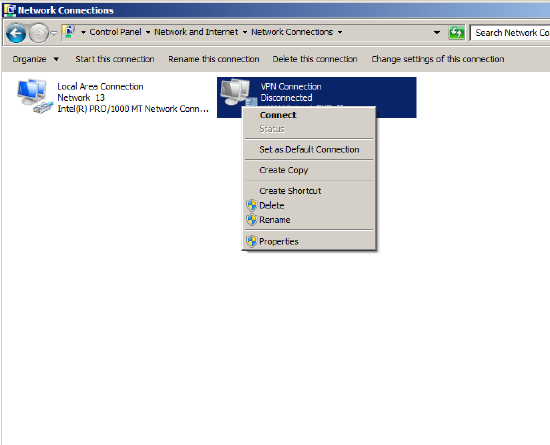For additional information, refer to the AnyConnect configuration guide.
Client Download
Unlike the ASA, the MX does not support web deploy or web launch, a feature that allows end users to access a web page on the AnyConnect server to download the AnyConnect client. With the MX, there are download links to the client software on the AnyConnect settings page on the dashboard, however, the download links are only available to the Meraki dashboard admin and not the end user. We do not recommend sharing the down link with users as the link expires after every five minutes of loading the AnyConnect settings page.
Open Start Menu - Search “VPN” - Click Change virtual private networks (VPN). From the VPN settings page, click Add a VPN connection.3 3. In the Add a VPN connection dialog: Set the VPN provider to Windows (built-in) Provide a Connection name for the VPN connection. Specify a public IP address (found in Dashboard, under Security appliance - Monitor. User authentication: Active Directory, RADIUS, or Meraki hosted authentication. Machine authentication: Preshared keys (shared secret) When using Meraki hosted authentication, VPN account/user name setting on client devices (PC/Mac) is the user email address entered in the Dashboard.
We recommend downloading the AnyConnect client directly from Cisco.com as there may be an updated version in the Cisco repository. Refer to the doc for the AnyConnect clientrelease notes. We also recommend using either Meraki Systems Manager, an equivalent MDM solution, or Active Directory to seamlessly push the AnyConnect software client to the end user's device.
AnyConnect requires a VPN client to be installed on a client device. The AnyConnect client for Windows, MacOS, and Linux are available on the Client Connection section of the AnyConnect configuration page on the dashboard and can be downloaded by a Meraki dashboard administrator. Please note, the download links on the Meraki dashboard expire after five minutes. The AnyConnect client for mobile devices can be downloaded via the respective mobile stores. You can also download other versions (must be version 4.8 or higher) of the AnyConnect client from Cisco.com if you have an existing AnyConnect license. AnyConnect web deploy is not supported on the MX at this time.

- Installing the AnyConnect client
- You only need the VPN box checked. Once the client has been installed on the device, open the AnyConnect application and specify the hostname or IP address of the MX (AnyConnect server) you need to connect to.
AnyConnect Profiles
An AnyConnect profile is a crucial piece for ensuring easy configuration of the AnyConnect client software, once installed. The MX does not support the use of custom hostnames for certificates (e.g. vpn.xyz.com). The MX only supports use of the Meraki DDNS hostname for auto-enrollment and use on the MX. With the Meraki DDNS hostname (e.g. mx450-xyuhsygsvge.dynamic-m.com) not as simply as a custom hostname, the need for AnyConnect profiles cannot be overemphasized. Profiles can be used to create hostname aliases, thereby masking the Meraki DDNS with a friendly name for the end user.
Cisco AnyConnect client features are enabled in AnyConnect profiles. These profiles can contain configuration settings like server list, backup server list, authentication time out, etc., for client VPN functionality, in addition to other optional client modules like Network Access Manager, ISE posture, customer experience feedback, and web security. It is important to note that at this time, the Meraki MX does not support other optional client modules that require AnyConnect head-end support. For more details, see AnyConnect profiles.
When a profile is created, it needs to get pushed to the end user's device. There are three ways to do this.
1. Through the AnyConnect server (MX): If profiles are configured on the dashboard, the MX will push the configured profile to the user's device after successful authentication.
2. Through an MDM solution: Systems Manager, an equivalent MDM solution, or Active Directory can be used push files to specific destinations on the end user's device. Profiles can also be pushed to the following paths:
Windows
%ProgramData%CiscoCisco AnyConnect Secure Mobility ClientProfile
Mac OS X
/opt/cisco/anyconnect/profile
Linux
/opt/cisco/anyconnect/profile
3. Manually: Profiles can also be preloaded manually to the same paths as listed above.
How to Create a Profile
Profiles can be created using the AnyConnect profile editor. The profile editor can be downloaded from the AnyConnect Settings page on dashboard or on cisco.com. Refer to this link for more details on AnyConnect profiles.
Using the profile editor: The profile editor can be downloaded from the AnyConnect Settings page on dashboard or on Cisco.com. The profile editor only runs on Windows operating systems. The screenshot below shows a configured server ton the Server List Entry option.
When configuration is complete, save the profile. It is recommended to use a unique file name to avoid profile overrides by other AnyConnect servers, then you can upload the file to the profile update section on the AnyConnect settings page.
Please note that only VPN profiles are supported on the MX at this time. This means you cannot push NVM, NAM, or Umbrella profiles via the MX.
- Select enable profiles, upload your xml file, and save your configuration
- After a user successfully authenticates, the configured profile gets pushed to the user's device automatically
- The result of the .xml can be seen below, after successful authentication to the AnyConnect server; this gives users the ease of selecting VPN servers on the AnyConnect client
The Meraki DDNS hostname is not easy to remember, therefore end users are not expected to use it directly. Profiles should be used to make connecting to the AnyConnect server easy for end users.

Cisco Meraki Client VPN only establishes full-tunnel connections, which will direct all client traffic through the VPN to the configured MX. As such, any content filtering, firewall or traffic shaping rules will apply to the VPN client's outbound traffic.
For remote teleworkers or users whose traffic should not be restricted in the same manner, clients can be configured to use a split-tunnel connection to direct traffic through the VPN only if necessary:
This article includes instructions for configuring split tunnel client VPN on Windows and Mac OS X. For standard Client VPN configuration on Windows and Mac OS X, please refer to our Client VPN setup guide. The rest of this article assumes a VPN has already been setup in this manner.
Note: This configuration involves manually adding entries to a client's route table, and should only be followed by users with a thorough understanding of routing mechanisms.
Configuring Split Tunnel for Windows
First, modify the properties of the VPN connection to not be used as the default gateway for all traffic:
- Navigate to Control Panel > Network and Sharing Center > Change Adapter Settings
- Right click on the VPN connection, then choose Properties
- Select the Networking tab
- Select Internet Protocol Version 4 (TCP/IPv4) and click Properties
- Click Advanced
- Deselect the box for 'Use default gateway on remote network'
- Click OK to apply the changes to the interface
Next, add routes for the desired VPN subnets. This should be done with the VPN tunnel connected:
- Open a command prompt (hold down the Windows key and press 'R')
- Type 'ipconfig /all' and hit Enter (Note: The name of the VPN will not be displayed unless you are connected to the VPN)
- Under the list of interfaces, find the Description for the VPN connection created earlier. This will be needed later.
- Run the below command replacing the relevant information between the <> markings:
Note: 'Destination subnet' refers to the local LAN subnet (in CIDR notation) on the appliance's site, not the Client VPN subnet specified in Dashboard.
Use the same command, replacing 'add' with 'delete' to remove the route.
Configuring Split Tunnel for OS X
First, disable full tunnel (all traffic over the VPN):
- Navigate to the specific VPN settings for OS X, located under System Preferences > Network.
- Click Advanced Settings
- Under 'Options' section, deselect “Send all traffic over VPN”
Add a new route to local routing table:
- Connect to the Client VPN
- Open the Terminal Application; normally this is located in Applications > Utilities > Terminal
- Verify the PPP interface that is being used for the Client VPN, this can be done by typing “ifconfig”
- As a superuser, enter the following command, replacing the relevant information between the <> markings:
Note: 'Destination subnet' refers to the local LAN subnet on the appliance's site, not the Client VPN subnet specified in Dashboard.

Ex. 'route add -net 10.3.0.0 -netmask 255.255.240.0 -interface ppp0'
To verify that the route was added take a look at the routing table, the new subnet should now have an entry. The route table can be accessed by typing 'netstat -r':
The route table will have to be modified depending on what networks will be accessed over the Client VPN (e.g. more than one network behind the concentrator). The interface will also have to be modified if there is more than one VPN configured on the client.
Verify Connectivity
Meraki Vpn Setup
Now that the route is added, a trace route can be performed to verify the direction of the traffic. All internet traffic should head out the normal interface and all VPN traffic should head to the PPP interface.
Meraki Vpn Connections
Note: These steps will have to be entered each time the VPN is brought up, but they can be defined in a script to make the changes quickly when needed. The specific process for this will be highly dependent on the operating system, tools available, and administrator preferences.
